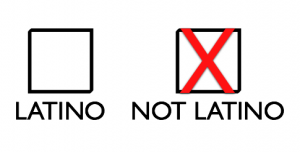6% Of Latinos In The U.S. Don’t Identify As “Latino”
 There is a reason that government and marketers in the United States want to dump all persons of Latin American ancestry into one big “Hispanic” pail. It’s the same reason that many people of Latin American Ancestry reject the notion. The Latino community is too varied and nuanced to to put in a box with a tidy bow. The best definition that we can come up with is to say that “Latino” is an ethnicity — better yet, a culture.
There is a reason that government and marketers in the United States want to dump all persons of Latin American ancestry into one big “Hispanic” pail. It’s the same reason that many people of Latin American Ancestry reject the notion. The Latino community is too varied and nuanced to to put in a box with a tidy bow. The best definition that we can come up with is to say that “Latino” is an ethnicity — better yet, a culture.
But that “best” solution has problems of its own. When you leave it to individuals to self-identify they will do just that — give U. S. Latinos a series of choices and be prepared for all possible combinations.
The U. S. Census did; it provided respondents the opportunity to self-identify by race and by ethnicity. So the result was the kind of all-inclusiveness that we know exists in the U.S. Latino community: Asian, Black, white, Latino, etc. What took some people by surprise is what approximately 2.5 million Latinos didn’t do: they didn’t check the Latino (Hispanic) ethnicity box. That’s about 6% of the people who listed Latin American ancestry but don’t identify as Latino. That was the conclusion of a study done by the University of Southern California:
Some first-, second- and later-generation Latinos in the United States are not identifying themselves ethnically as Latino as they integrate into the fabric of American society, a recent study by the USC Dornsife College of Letters, Arts and Sciences found.
This has all manner of social implications, but let’s look at them more practical repercussions first:
Data from U.S. Census Bureau surveys are used to make population projections and track the minority groups with the largest and fastest educational growths, and 2.5 million people with Latin American ancestry are left out of these analyses.
Money and resources are allocated using the Census numbers as a baseline and indicator of where they are most needed. There’s an obvious problem with this accounting. There may be needs, but they won’t be taken into full account because of the way people self-identified. This isn’t restricted to the Latino community. Barack Obama, according to the USC study summary, identified himself as black, and not multiracial, forgoing, at least officially, his white ancestry.
Why is this happening? The USC researchers have some ideas:
- respondents’ confusion with the terms ethnicity, ancestry and race often result in inconsistent answers on the U.S. Census surveys
- some Latin Americans see themselves as non-Hispanic because a racial identity has become more salient in their daily lives
- daily interpersonal interactions, being born in the U.S. and traditional processes of assimilation, such as language assimilation, socioeconomic advancement and interracial marriage also may lead some people with Latin American ancestry to drop their Latino ethnicity in favor of a singular racial identity
Does this mean that ancestry should be weighted more than ethnicity for official purposes? That opens an entirely different can of gusanos. But the study reveals the complexity of assimilation, or acculturation (you can check a box next to the term you like best). As one of the study’s lead researchers, Agius Vallejo, said:
[]“People with Latin American ancestry who do not identify as Hispanic may be a harbinger of future patterns of assimilation, but because these people are left out, we might be underestimating the extent to which Latinos are assimilating into America’s core social structures.”

